
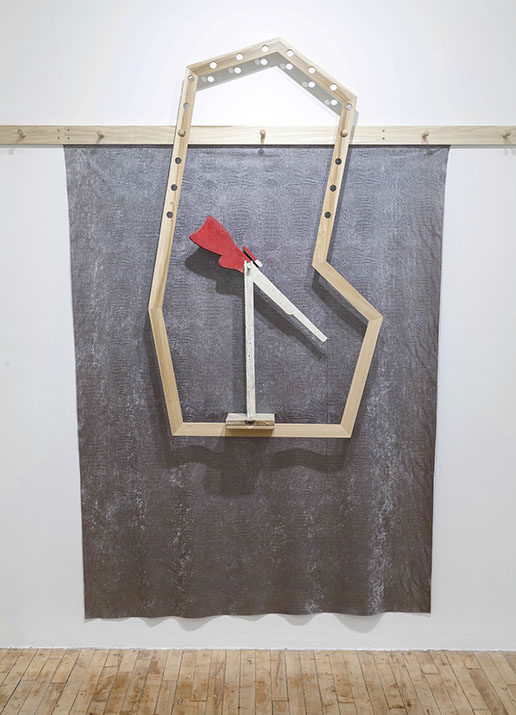
My Father Made This For Ice Fishing When He Was A Kid, 2015
wood, fabric
75” × 60” × 8”
Mark Sengbusch with Stephen Eakin
I met with Stephen Eakin to discuss his show Permanent Collection at Honey Ramka gallery in Bushwick off the Morgan L train stop.
His work is both serious and humorous, I wondered about his childhood, specifically his High School years. The works in the show reference his family, his parents, grandparents and his fiancé– fellow artist Heather Garland. He has incorporated objects that belonged to these people. His late father’s lacrosse stick –wooden, hooked like the original Native American style– a bowling trophy belonging to his Grandmother, and an acting award. And one of my favorite works in the show Heather said I could use this t-Shirt as a rag. I remember seeing and enjoying this piece when it was shown at the Vasquez building in a show organized by Paul D’Agostino.
There are other potent objects incorporated into these works. Arrowheads, a tireless bicycle wheel, and PlaySkool puzzles belonging to Eakin. He said he found some of these objects at his parent’s house tucked away in the back of a closet. There is a recurrence and back-and-forth of uncovering and excavating, burying and submerging.
We discussed the elements of craft, craftsmanship, furniture and sculpture. I found it very revealing and it opened up a larger discussion about the history of American crafts as well as the resurgence of craft in the contemporary art scene. So lets start there.
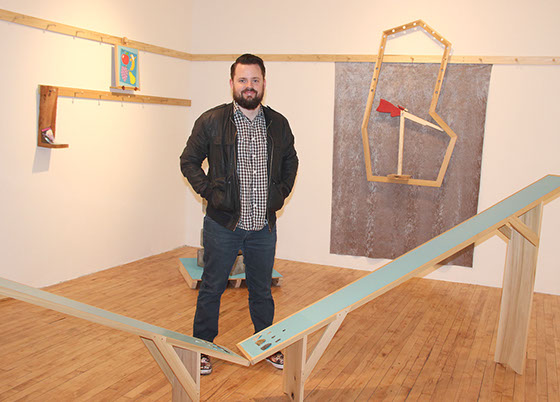
Stephen Eakin with Permanent Collection (installation shot)
Photo: courtesy of Rafael Fuchs
Craft
MS: This work is all very well crafted. The exposed Poplar, the exposed wood plugs and interlocking joint work. What is the origin of this?
SE: I am interested in understanding how objects come to have value for us, and how we build relationships with them. I think of artworks as eventually ending up in a collection of someone’s belongings (or institutional belongings), and am interested in how all those things end up being collected. In thinking about that crossover of art objects and personal belongings, furniture quickly become sculptures. A tabletop is a place for a thing like a pedestal in a gallery. The home is also a personal mental space. Hidden objects are memories. So any given object in one of my sculptures becomes a kind of stand-in for some other idea, mainly about art and what we are doing as artists making things. Craft becomes part of this mainly through working with furniture as an idea. Craft is something I’ve always been interested in, but not beholden to. I also find in working with found objects as subject matter, adding a handmade element really shifts the conversation, and adds a clear intention to all of the decisions.
As a student I learned about the Shakers, primarily as craftspeople. They are like the Quakers, but mainly get their name from the dancing involved in their worship. Their full name is The United Society of Believers in Christ's Second Appearing. They’re an interesting religion for a lot of reasons, but the most important relationship the Shakers have to my work is how fundamental they are to contemporary furniture making– and object making in general. They were highly inventive, and it was a Shaker sister that came up with the design for the first circular saw, which is a tool that is widely used in all art making. You can’t even stretch a straight canvas without a good table saw to rip those stretchers with.
The Shakers see the labor in making a thing as a kind of spiritual act that concerns their relationship with their God. The tools, the shops, all aspects of the process are important for this reason. The entire act is transcendent for them. There’s a great Ken Burns documentary about the Shakers. In an interview, one of them describes the desire to make a chair that an angel could sit in. I’m not sure I even believe in angels, but the idea that a person can make an object that transcends mortality feels like it’s at the core of a lot of art making. And that is interesting to me. Craft is all wrapped up in that– an expression of labor, of time, of commitment in a lot of ways. So I took some of those things on in making this body of work.
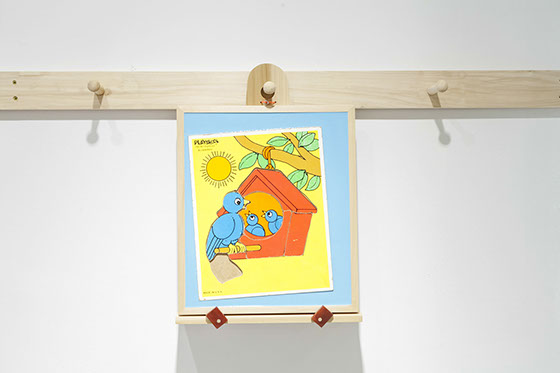
My Mother Held On To This Puzzle That I Don’t Remember Playing With (2), 2015
Wood, rubber polymer, found object, nylon twine
18” × 13” × 3 1-2”
Photo: courtesy of Honey Ramka
MS: The Shakers always included an intentional flaw in every piece they made because “man should not aspire to the perfection of God. Flawed, they believed, could be ideal. This move is common in many other cultures as well. Humility squares in Early American quilts, cracks in Japanese vases etc. Can you relate to this? Maybe there is a non-religious significance about slight imperfection. Like Marilyn Monroe’s Mole, Kurt Cobain’s cracking voice, or even the trend of Japanese women getting “Snaggle tooth” surgery (tsuke yaeba).
SE: I’m not sure to the extent that the Shakers really believed that. I think they were humble aesthetically and strived for a real sense of simple perfection. They definitely didn’t believe in bright colors or outlandish decoration, as it distracted from their intentions. Though they definitely made beautiful things. Wood grain was the only real place that decoration happened, and that might be some of the imperfection you are referring too. They let the wood be itself, knots and all.
I am quite familiar with the Japanese philosophy of Wabi-Sabi, which is all about that kind of reveling in the imperfections of a thing trying to attain perfection. But those imperfections are what makes it perfect. Part of it is about seeing the maker’s hand and the kind of uniqueness in that. Art is invested in the unique. The more one-of-a-kind a thing is, the more value it can have. Sometimes it’s hard to recreate those imperfections ever again. There’s a piece in the show I kind of came to through a mistake. But that mistake forced me to work with it just because I didn’t want to trash those materials quite yet. It got me to a new idea. People talk about ‘happy accidents’ and in a way, it’s part of that same historical tradition. Things that should be mistakes can end up as that next unachievable thing– a way to a transcendent “object”.
But as someone who gets uncomfortable with too much consistency, there are moments in the work where I definitely play with how far I go into that craft. The Nirvana piece is a good example. Some of the paint application in other pieces, too; I decided wherever I used paint, I would be a little more gestural with it– letting it drip and run and leave marks. Thinking about that sense of slight imperfection as an improvement.
MS: I noticed that about the Nirvana piece. It’s fitting that you would make this piece slightly flawed to show the natural beauty. I always thought that about Cobain’s voice, especially on the Unplugged Album.
Being an artist trained in an Arts and Crafts tradition, as well as a hard edged geometric abstract painter myself, I am often confronted with the hopefully flawed, unbalanced and gray equation: if an Artwork has high Craft, it must have low Concept. And if an Artwork has low Craft it must have high Concept. Like “Oh shit, look at that pile of clothes on the ground with a canvas leaning against the wall backwards. Man, that artist obviously must have spent a long time thinking about the meaning of these elements.”
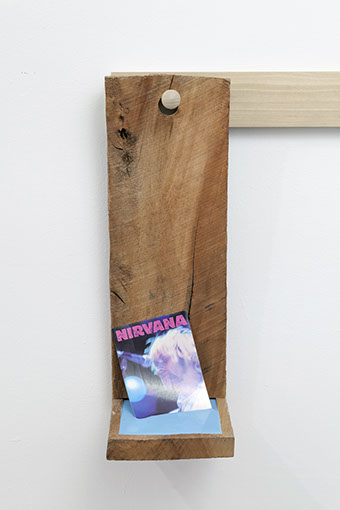
I Don’t Remember Where I Got This Nirvana Sticker But I’ve Had It
For A While, 2015
Wood, rubber polymer, found object
17 1-2” × 6” × 6 1-2”
Photo: courtesy of Honey Ramka
To distance one’s self from the world of craft, design and decoration just makes it sloppy. This move is so old that today it actually takes effort to “make work” look like it didn’t take any effort– like doing your hair to make it look like you just got out of bed.
SE: I think there is a craft in those kinds of “sloppy” aesthetics. I think any time you try to hone an act, you start turning it into a craft, even if honing it means finding a way to make it earnestly sloppy– that idea where having no style is a style like how Normcore is a thing (or maybe it’s already not. Usually by the time I hear about things like that the joke is over). And really what’s happening is we’re turning bucking-against-tradition into tradition. So to then to buck against that, we have to stop bucking against tradition. So we’re back to tradition. It’s a swinging pendulum– there’s only two directions if you look at being either for or against something. There was a great panel talk at BAM recently all about craft finding some new footing in art. It was organized by the curators of a serial group show called Static Cling: Maria Britton, April Childers, and Robin Kang. People were very engaged; it’s such a slippery topic. There was talk about the delineation between craft and craftsmanship, but I also think the bond between the two is a sense of following tradition, which in art is still kind of considered naïve or just ‘not new’.
MS: I’ll quote you here again from earlier because I think it is a very graceful, honest, respectful and humbling statement: “there is a craft in those kinds of ‘sloppy’ aesthetics.” Touche.
I’m glad you brought up the BAM panel talk. I’ve discussed this in depth with Robin Kang. There is indeed a resurgence in craft that is fused with fashion/design/Pop. My favorite galleries in Chelsea are clothing stores like Anthom.
SE: It’s probably all linked– the desire for more handmade, more traditional things. It’s a reaction to the powerlessness that comes with improving and ubiquitous technology. None of us really own much of the things we buy; we just kind of use them until we have someone fix them. We’re generally beholden to whatever Apple or Microsoft tells us (unless you happen to be adept at fixing those things, which even then takes a huge amount of brainpower). I think it’s actually empowering for people to have things that they understand the making of, that they can see that making of. I think that’s why abstract painting is seeing such a rise again. We like being able to clearly see that a human, not a machine, made that thing. Clothes, food, and all of those familiar traditions are back in fashion for similar reasons.
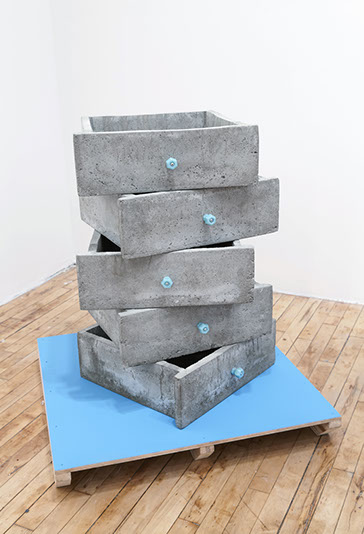
Moving Day, 2015
Wood, concrete, paint, glass
34 1-2” × 30” × 30”
Photo: courtesy of Honey Ramka
MS: I was at the opening of 247365’s new space at 57 Stanton in the LES recently. It was packed. I was in the back room and someone almost set their beer bottle down on a sculpture saying something like “you think this is okay?” Yo, nah, not cool, dude. WTF. Maybe this sparks a nice conversation about “What is and what isn’t ART”. In craft there is function at the core. But I don’t drink out of my ceramic vessels and I don’t play with my mint-condition-in-the-package Transformers. But with Art, the function is less clear. Hmmmmm…
But this works the other way around too. There is a great bit from Eddie Murphy’s “Delirious” about how no one cleaned up the dog shit when he was a kid and his Dad flips out. “The shit is rock hard, my friends come over and they put their drinks on it and say ‘this is beautiful’. Its not beautiful, its SHIT!”
SE: It can all be traced back to the way a context of a thing shifts its meaning, a fundamental idea in working with found materials, and arguably fundamental to all art– that’s what Duchamp’s urinal is. That’s what the film ‘Cave of Forgotten Dreams’ is. Marks on a stone don’t have inherent value to us. Modernism might try to say they do, and formalism wants us to think it’s its own language. But then you watch a 3-D movie Werner Hertzog made about marks in a cave, and it tells you how old those marks are and about the guy that had to crawl deep in that cave to make those marks, and suddenly those marks are mind-blowing. You have the context now. You’ve done some research. Suddenly those marks aren’t just pigment on a rock (which, however, can have it’s own beauty), they’re evidence of a historic event. And they get huge amounts of value added to them because of that knowledge. Even without that background information available, at the very least they’re evidence of an artist. We know that because we come to those marks with the knowledge of what marks look like. The first thing that happens when we look at art is we try to find recognizable things in it. An artist might recognize marks and textures and materials. A writer might look for letters and narrative. A child will probably see his favorite things– which may also just be the marks or maybe he sees a Barbie doll. It’s why two people can look at the same painting and one can see it as revolutionary but the other can scratch his head and say, “this is art?” The point is, it’s rare we take things as they are; we inevitably seek to understand them.
So we as artists can look at that pile of clothes and understand that it’s probably in some way bucking against a tradition of high craft. But not everyone will walk in there and even have the knowledge of those traditions to pit that sculpture against. But because it’s put in an art space, they will generally know that they are being asked to think about what they are looking at. People will try to figure out a relationship with it. That same pile of clothes in a bedroom means laundry, and so just putting something in an art space changes it. I really like that though. I like that maybe some of my sculptures would just be a table or some cast off object somewhere else. I think conceptual art revels in that, but people hate conceptual art, probably because a lot of it just works with familiar things people can’t look at as art. There is something irritating about trying to make art equivalent to everyday things. I think it goes back to the mythology of art objects as somehow transcendent. They are art objects because in some way, they are beyond every day things.
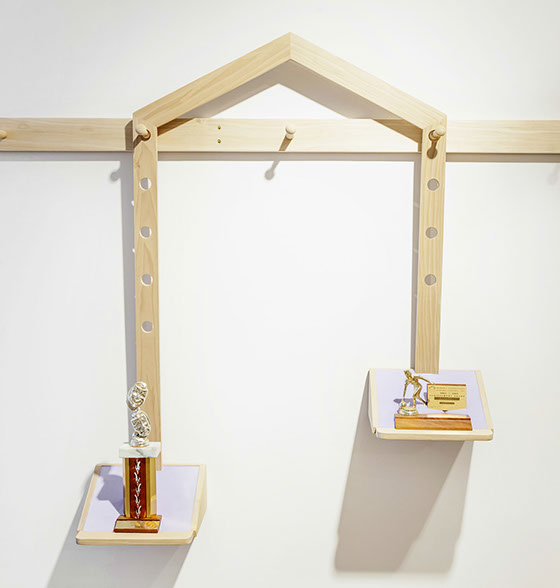
I Didn’t Know My Father Was An Actor Or My Grandma Was A Bowler, 2015
Wood, silicone rubber, trophies
40 1-2” × 33” × 8 1-2”
Photo: courtesy of Honey Ramka
Nostalgia
MS: You have incorporated objects into this body of work from a range of contexts and time periods including your father’s Lacrosse Stick, Trophies, Arrowheads, PlaySkool puzzles from the 80’s, and a picture of Kurt Cobain sticker. Upon first look I wasn’t sure if these objects were there for purely aesthetic reasons or if they had a deeper significance. There are some telltales though, even without consulting the image list. Both the Lacrosse stick and the trophy are labeled/inscribed with your family name Eakin. Are you nostalgic for these objects? Do they tell a personal story and/or have specific value you to you? Can they act as universal symbols/icons?
SE: Yes they all have some sort of value, but different levels of it. I think at least in middle-class American culture they are pretty recognizable as personal artifacts. Art objects, generally speaking, are personal artifacts– especially fundamentally handmade things like paintings or ceramic sculpture. They’re evidence of their maker. So I definitely like that they hint at deeper stories, but it’s also clear that those deeper stories require research. It’s all an analog to the way we look at art. We need the stories and the context for a lot of it to make sense enough to build a relationship to it. I’m curious about how much context we need in order to have a relationship with an object and where that context comes from.
I work in a warehouse as an art handler and spend my days surrounded by art objects that are stowed away in wooden crates and cardboard boxes. That industry runs on people paying for the square footage to just keep things. Those things aren’t being looked at, not even by the people who see them every day. They’re all stuffed bears in a closet or trophies on a shelf in a lot of ways. Sometimes I think art collecting is just privileged hoarding.
MS: Have you referenced your family in past work?
SE: Yes. It’s kind of a long story, but it started in grad school. I spent a semester on one project, a film/performance/installation thing where I deeply recounted what happened to my father when he got sick. He died in 1996 after an intense battle with brain cancer.
By the end, he had lost his sight, and didn’t have much control over his motor skills and speech. He would try to get himself up to walk to the bathroom and couldn’t see to find his way, but couldn’t adapt because his short term memory was shot and he couldn’t control his body very well. They opened his skull and put radioactive material into is head and sewed it back shut to try to kill cancer cells, but it had all of these side effects. It was a tragic mess, and really kind of put my family through the ringer. Some of my relationships with extended family never recovered and my brother and I have always feel like black sheep wherever we are in part because of that. The rest of the family really just didn’t know how to help us. I don’t blame them. I really turned to art then, drawing a lot. It helped me maintain and make new friendships, and was a way for me to relate to people.
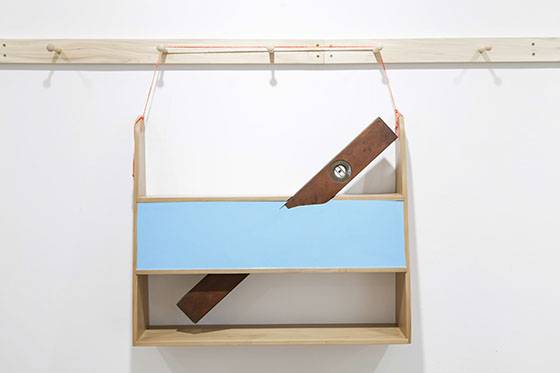
I Found This Level In My Grandparent’s Barn, 2015
wood, found object
27” × 31” × 7”
Photo: courtesy of Honey Ramka
The artwork about his death is an 8mm film of me spending a day roughly the way my father did near the end. So I filmed myself locked inside a friend’s apartment I had never been into, and spent the day blindfolded. I wanted to try to understand what it felt like to have that hard of a time in your surroundings. It was sad approximation, but was hard enough to not see for a day, to wait for the sound of the door to open when someone showed up with a sandwich, or to feel my way to the bathroom. I also recorded my mother’s retelling of the story of my father’s illness over the phone. It was something like an hour and a half long. I listened to it on repeat through the duration of the performance.
The revelation in this work (which in hindsight was really, REALLY dramatic) was that all the art I was making was really about me (what art isn’t really just about its maker?), and probably about things I wanted. Close family had kind of become distant relationships. I still feel like I’m trying to connect with family, but also feel like I’m giving up on it a little. Maybe as I get older I just get better at accepting things as they come. Plenty of people feel this way. It’s nothing new, but it’s a big part of this work.
There are a lot of people that think being overly autobiographical leads to being too sentimental and they are afraid to even get close to that. In this age of irony the worst thing to be is sincere. Being jaded and funny and tongue in cheek definitely goes over easier. It’s easier to look at. And in the social setting of an art opening, there’s no risk of people getting overwhelmed with sadness or fear or longing, because nobody likes to do that in front of each other. We like to laugh when we’re out doing things together.
But I also think it’s easy for autobiographical work to turn too awkwardly personal and sad. That first piece I made –the 8mm film– people cried at, and would leave in anger. Some people think (and have told me) it’s exploitative to make art with emotional material that way. I felt like my viewpoint was very objective, and over the years I’ve learned how to keep enough distance from those narratives in the work that people are allowed to think about the ideas I am after, without the road blocks of heavy emotion. Humor helps it. I’ve found certain color palettes help it too. I try to keep the work a little whimsical now, so that the heavy ideas about mortality don’t overwhelm the rest of the content. It also makes it feel relevant to right now, a time when humor in art is probably more valued than it has been. But really death is at the nexus of the whole thing.
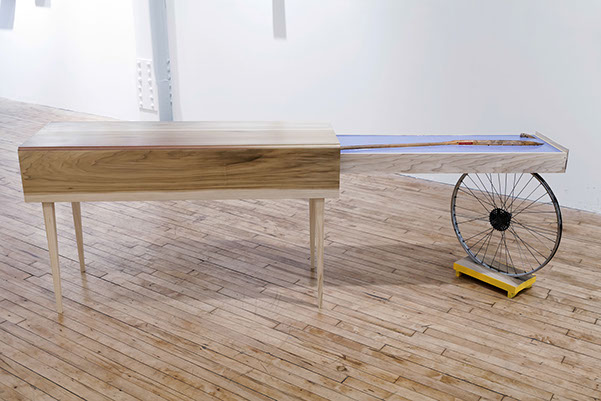
I Found My Dad’s Old Lacrosse Stick In My Grandparent’s Barn, 2015
Wood, silicone rubber, my father’s lacrosse stick
94 1-2” × 32” × 19”
Photo: courtesy of Honey Ramka
MS: What is your Mom’s reaction to the work about your late father?
SE: I think she feels kind of sad about it, but is also pleased that I am making this work. She’s supportive, and thinks that if my father knew I was turning his old stuff into sculptures he would probably laugh and be pleased. It’s important the things I’m working with are not automatically relics, but something that was maybe near forgotten, but hasn’t left. I like discovering these things, coming across them and having my curiosity peaked. Anymore I’m not even sure the work is about those stories. The work is about how objects carry stories. The stories are just kind of part of the objects and vice versa. They’re what give the objects value in the first place. And I’m working with other kinds of objects now, things from people still around me– close friends, family. I have a lot more work to do, and work to make to cover this territory. I think it has an end, but feels very rich to me right now.
MS: Your fiancé Heather Garland is an artist too. Do you critique each other’s work?
SE: Yes, we do. We like each other’s work a lot so it’s rare that it’s out and out negative. We’re good at just telling each other when something is really good. It’s kind of a given, I think, if we don’t explicitly say that, that it needs more work (though sometime we explicitly say it). It’s a great thing, really, to be with such a different artist, but one who I respect and kind of am always puzzled by in a good way. We definitely continue to surprise each other as artists. She helps me with a lot of decisions in my work. Some of the strong moments in the current show came directly from her. Her eye and intuition are a little better than mine on that end. I’d like to think I help her the same way, and it may just be because we’re both smart artists that know how to look at different work and think about it. Not all artists are like that, but we thrive on that kind of pluralism. We love work that is different than ours. I would hate an art world that was all in the same genre as my own work and so would Heather. I think that’s why we get along. We’d probably have a harder time if we were too similar as artists. When we borrow from each other, it doesn’t feel like we’re stealing ideas because the work is so different. We don’t worry about competing for attention either, because the attention for our work will inevitably come from different places.
MS: Is it difficult to talk objectively with each other about your work?
SE: Yes, at first, there was some antagonism there. It was hard for us to talk to each other without questioning if the other person even liked the work at all, which is just part of getting to know someone. But we’ve been together for a few years now and the trust is quite strong, so we can be pretty direct and not have it be about how we feel about each other. Those kind of relationships are really important for artists, but it takes time to find people that know how to build them– friend or otherwise. I have lots of artist friends that I don’t think would, at this point, give me a good studio visit. Some of that is just not having a way to talk about the work I make.
MS: In the piece titled “Heather said I could use this shirt as a rag” I see the found object of the shirt less symbolic than other objects in the show. It even says in the title how it came to be. Would you agree that Heather’s t-shirt is less loaded than say, the arrowheads? I like the implied story of this piece. It’s not cryptic. Is it like an homage or a token? Maybe it can act as a metaphor too– like a woman who gives her handkerchief to her man. She wipes the sweat off his brow with it and then says, “Keep it, to remember me.” In this case the sweat is paint!
SE: Ha! I’m not even sure it goes that deep or traditional in the gender aspects of it. It is definitely not as loaded as other objects, and I am very interested in that spectrum. I think in a show like that, having a mixture of things helps each individual thing to be more revealed. Pluralism is important. Having this old throwaway shirt next to very carefully kept arrowheads reveals each object more. At the same time, many of the objects are things the owner stopped caring about. But that’s kind of why they stuck around. They got lost in some closet or garage– forgotten about and then dug out later.
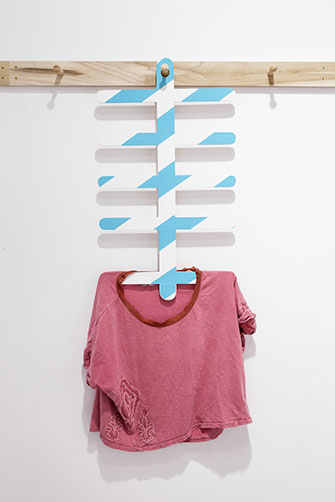
Heather Said I Could Use This Old Shirt As A Rag 2015
Wood, paint, Heather's old shirt
46” × 20” × 1/2”
Photo: courtesy Honey Ramka
MS: The most powerful reference in the show to me is the Cobain image that we discussed earlier. We are both about the same age and I definitely have nostalgia about 1992-1997, I remember clear as day the first time I heard Nevermind on the bus home from school. My older brother and his friends were listening to it on a Walkman. By the time I got a turn to listen it was at the end of the album– “Something in the way”. I think artists and most people are branded by their teenage years. Look at the work of Alicia Gibson or Yasamin Keshtkar (both artists that have shown at Honey Ramka). Were your high school years influential to your thinking or artwork?
SE: The Nirvana piece is a definitely a tangential piece– in a good way. It’s a pretty didactic pop culture image for me to work with. I think that’s why it stands out to most people. I told Heather that I thought viewers would either think it was one of the strongest pieces in the show or they would hate it and dismiss it– both for the same reasons. The construction of it is a little different than the rest of the work in the show. I didn’t really finish the wood at all. I tried to make one of those hanging forms in as few moves as I could, just a few cuts in one piece of wood. The wood is actually old barn boards from my grandparents’ property. There will be more forms like that in the future for sure.
I hated high school. We moved a lot as a kid. The thing that helped me make friends was art. When someone learned I could draw really well, I was suddenly worth something to them. I’ve never been someone that won people over easily. Art has always been social for me– a talking point.
I listened to Nevermind a lot after we moved from Florida to Hawaii. That was in 1992 or 1993 I think. I was about 11 years old. I have vivid memories of coming home from school, before I really was making friends, and drawing and listening to that CD. Green Day and the Beastie Boys were the other records I remember at that age. I was 12 or so around that time. I remember being in the car with my father on the way to school and hearing over the radio about someone finding Kurt’s body in his pool house in Seattle, but they hadn’t identified who it was. I remember the shock at the idea that someone could so violently destroy their face that it was unidentifiable to people that found the body. Death was not yet a big part of my life. I think by then both of my grandfathers had passed, but I wasn’t taken to either funeral. I think my father’s funeral might have been the first one I went to. Kurt killed himself in 1994 and in 1995 my father had his first seizure. He passed in 1996. I think Nevermind was an album I heard a lot during those years.
MS: Who were some early visual artists you were exposed to (or “Non-Art” things/ideas that influenced you artistically, i.e.: sports field design, architecture)?
SE: In grade school it was comic books, cartoons, and movies. For a long time I wanted to make movies. I did some stop-action movies with Legos. In high school, I got a more direct introduction to sculpture, but didn’t really find it until college. The activities of drawing and building were always filling my time. I don’t think actual knowing artists came until much later, mainly as a responsibility to understand where I fit. Now I know what camps my work fits into and what art I like. But early on, I just wanted to make and didn’t care much about who else was doing what.
MS: The wooden Playskool puzzles are from your childhood, correct? Do you remember playing with them? Is it possible that these were the seeds of your interest in woodworking?
SE: I don’t remember them at all really. I doubt they have anything
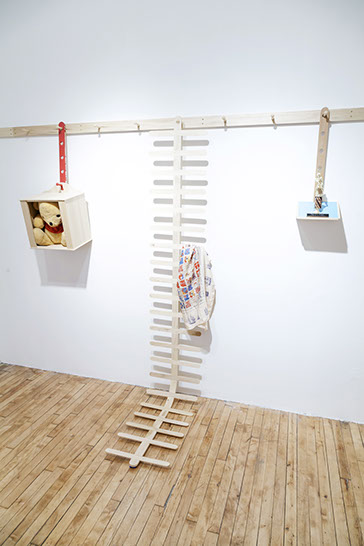
Permanent Collection (installation shot)
Photo: courtesy Honey Ramka
to do with woodworking. Woodworking for me is less about the actual material and more about the process. I really like building things. There is a serious satisfaction out of making parts that fit together. I played with Legos obsessively as a child. I would get kits and want to build the kits following instructions. It was very goal oriented. If something was not put together right, it bothered me. I made models too. I think that all informs this work, where I am following plans and designs (traditional carpentry) laid out by others, but adjusting them and adding to them.
I made a piece about the first model I remember building– the aircraft carrier USS Enterprise. It is also the boat my father served on in the navy, and where he met my mother (at a function on the boat). It’s also a boat Tom Sachs makes a lot of work about, as it was the first nuclear aircraft carrier in the Navy. I remember my frustration at not being able to paint the hull well and trashing the whole kit. I bought the kit and rebuilt it. So crafting well has long been something I’m preoccupied with, but I don’t think it’s healthy or right to be dogmatic about it. Like I said, I love art that is different from mine as much as I love work that is the same. Every genre can have a good and a bad. Some have more bad than good and vice versa.
It’s so counter to what Art is, which is so invested in breaking tradition. Really, I think evolving traditions makes more sense. Following what is laid out for you, but then moving it further somehow. I think the return to craft in the art world is, in part, that realization. I think artists are rebels and loners and by definition need to subvert what came before them. The world needs people looking to do that, to keep us all on our toes, to constantly hold up mirrors and say “do we still think this way of making things is the right way?” The point, of course, is to keep pushing what we know. To keep expanding and redefining our understanding of ourselves and of the world so that we really know whom we are. I think my sense of rebellion has kind of always been about questioning the didactic rebels as much as the authority, and inevitably landing somewhere between. We don’t always have to overtake our predecessors to have a seat at the table. Sometimes we actually benefit from sitting next to them.
MS: What other toys did you play with as a kid? Would you ever make a big mess out of your toys? Or were you always respectful and orderly with them and cleaned up after playtime?
Well I already talked about Legos. I had tons of toys. Sometimes I would just dump a bin on the floor and figure out what I wanted to make and make it. But as I got older, I wanted more complicated things that I had to try to replicate. I actually think copying, as frowned upon as it is, is a big part of craft and a big part of how I came to art.
We also had these things called Omagles, which were like giant PVC erector sets (I had Erector sets and Capsela as well). The Omagles were great, because they were big enough to build things that my friends and I could climb inside of. They had big wheel pieces and we always made cars and things to push each other around in. I don’t think we cleaned up, we usually made things and then tried to keep them together for a long period of time until we wanted something new. But there was definitely something important about that modularity, building something, erasing it, and starting over. I do remember wanting to be respectful, trying to keep all the pieces together, which felt mostly about not removing some sense of future possibility. If I lost a piece, then the next time I might need that piece I wouldn’t have it. And that was a bummer.
MS: Do you feel that there is an irreverent level to your work? Can it be both serious and humorous at the same time?
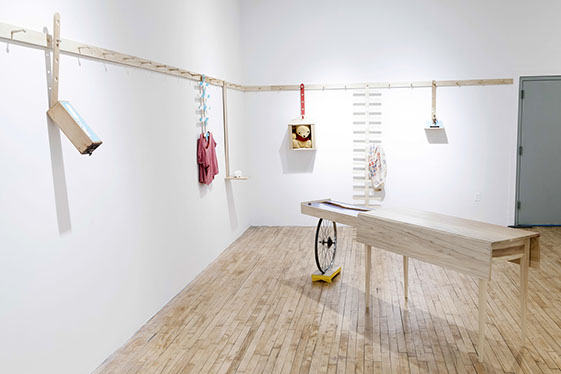
Permanent Collection (installation shot)
Photo: courtesy Honey Ramka
SE: Humor has become more important. I like humor in the rest of my life. My work has always been serious and I’ve always liked dramatic stories. So I’m not sure if I am normally pretty serious and learned to use humor as a means to connect with other people (that’s pretty common for kids that don’t otherwise get a lot of interest from other kids when they are young) or if maybe I’m actually really funny and think my work needs to be serious. I lean towards the former.
Lately I’ve been bringing humor into the work more, to get it out of some of the more serious, sad, nostalgic stuff a little– to lighten it up, break the ice, make people feel comfortable talking about it. Comedy is fantastic for that, especially with touchy subjects like mortality. I also like funny art. I like to be funny.
MS: Your personality matches that. It is a good quality to have. Both light hearted and serious. Has anyone ever compared your Art to your life?
SE: I think it’s inevitable with the content of my work that people will ask about my life. I’ve learned to become comfortable telling many very personal stories in public. It’s part of the artwork.
MS: Can you describe Honey Ramka’s program/vision?
SE: Well I think they are in the early stages, but I think what I like about them is how serious they are about getting the gallery off the ground and building its reputation, but how they are also clear and uncompromising in their vision. I’ve seen other artist run galleries start in a similarly experimental fashion but then slowly decide to just show popular contemporary painting or something like that, probably because it sells (or they think it does). I love good painting, there’s nothing wrong with that, but there’s something really positive about the Gallery directors Bryan (Rogers) and Jesse (Patrick Martin) wanting a more diverse gallery program and wanting to shine light on artists that are still in the dark. They are also really aware of what else is happening and they’re doing well at staying in the conversation.
MS: What have been some of the more memorable shows you’ve seen here?
SE: I really liked the recent Elizabeth Ferry show. She’s got a lot of different things going on with her work that I got into. The faces, big Styrofoam forms, and the stacked frog paintings were all great. Also, Polina Barskaya’s last show in the project space was great. I’ve seen a lot of her watercolors, but that show had a lot more painted panels that really changed the vibrance, texture, and detail of her images in a luscious way. I loved how dramatic and simple that transformation was to observe. Bruce Stiglich had a really great installation piece there, too. I actually wrote about that show for Painting is Dead. And “Wretch”, a group show with some of my favorite painters like Katrina Fimmel and Rebecca Morgan. I think those two ladies are doing really unique, provocative things that they really own. You see that work and know who made it, you want to dig into it.
MS: Last questions, favorite comedian?
SE: They all have hits and misses. I’ve still never gotten over The Dave Chappelle show. That feels like it was an important thing to happen in comedy in our lifetime. And it really started to crack some things open about race in our country in a brilliant way. Mitch Hedberg has some classic jokes that will never tire for me. Jim Gaffigan has some good self-deprecating stand-up with some really dark cultural undercurrents to it. Louis CK is great. I secretly love Tim and Eric.
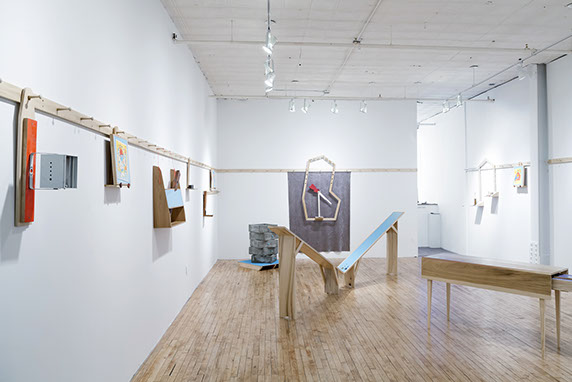
Permanent Collection (installation shot)
Photo: courtesy Honey Ramka
Stephen Eakin will have work in JONALDDUDD at City Bird Gallery.
191 Henry St., New York, NY 10002 as part of NYC Design Week 2015.
Open Friday May 15th - Sunday May 17th, 11am - 6:30pm, with an Opening Reception on Saturday May 16th, 7 - 10pm. After party at Beverly's 10pm and on.
More details at jonalddudd.com
Stephen Eakin
Honey Ramka is located at 56 Bogart (Morgan, L train).
Look for their booth at NADA NYC (May 14-17), solo presentation of work by Elizabeth Ferry.
Mark Sengbusch is an artist who lives and works in Brooklyn, NY.
Disclaimer: All views and opinions expressed are those of the authors and do not necessarily reflect the views of the editors, owner, advertisers, other writers or anyone else associated with PAINTING IS DEAD.
